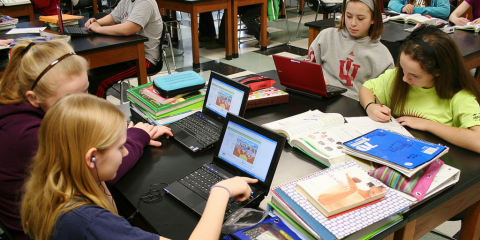Classroom Management in a Techie World

One of the most common questions we get from teachers who are just starting to use more technology in their classrooms is “How can I keep students on task?” The question is certainly not new. It’s something teachers have been wondering since the days of the one room schoolhouse. However, when each student is holding an access point to an entire world of online material, it seems even more overwhelming to keep them focused on their assignments. With that in mind, we’ve put together some tips for how to make sure students stay focused on their work when they should.
General tips:
-
Establish an “acceptable use policy” for your class. Even if your school already has a policy your students must sign, establishing rules for the class that you specifically outline and discuss is helpful and will reinforce the school’s rules. It’s also a great idea to establish these class rules together, perhaps on the first day of school. Ask for a volunteer to jot down what is decided and then have all the students sign. Post the sheet in the classroom or in your LMS. Involving your students in the process of setting up these rules gives them agency and makes them more committed to following the rules.
-
Come up with specific keywords to facilitate transitions. For example, “pizza box position” is a term often used to mean students should half-close the lids of their laptops so they are not shut down, but all eyes are on you and nobody is typing. Repeating concepts like this will prevent you from constantly having to explain what you want.
-
Make moving around the classroom throughout class a consistent part of teaching. Not only does this allow you to help individual students who may be struggling, but if this is something you already do it will let you easily monitor screens without being overt.
-
Draw on help from administrators and the IT department in making sure student devices are restricted enough to keep students safe online but open enough to allow them to do research and projects easily. Help students develop good digital citizenship skills by providing them with rules and structure, but also enough flexibility for them to demonstrate responsibility. If all of your devices are very limited in what students can access, that might keep them on task but it does not teach them how to be good users of technology. Discuss concepts like their digital footprints, the importance of staying on task, and how to find reliable sources. Then, let your students show you that they have internalized these skills.
-
Remember to keep what you are doing with the technology purposeful and meaningful. If students are using technology as a simple replacement for paper tools, they very well might go off task. However, if the projects are things that are truly transforming instruction, they should be engaged and on task. For instance, using iMovie to create an animation about the Civil War is a transformative and engaging task. Writing an essay about the Civil War is the same pedagogically on the computer as it is on paper. If you aren’t sure about ways to make technology more innovative in the classroom, talk to your school’s technology integrator.
Tips for off-task students:
-
Learn the device well so you always know how to check on a student’s device if need be. For instance, if you have a class of iPads, know that you need only stop by and doubleclick the Home button in order to see what apps the student has recently used.
-
If a student is off task, no need to disrupt the whole class. Simply close the student’s laptop or put it on your desk. The student can then continue working with a paper and pencil. Have the process for this clearly outlined in your acceptable use policy so students know how it works. If this makes it difficult for a student to complete the task, it is not up to you to make it simpler for them.
-
If you have a student who is prone to being off task, assign them specific tasks that will keep them focused. They can be the class note-taker for a discussion, or look up vocabulary words the group is not sure about. This strategy ensures the student is kept on track.
-
Remember that misusing technology should be treated just as any other discipline problem. If you had a student who kept passing notes after many warnings, you would move to other levels of discipline, like a discussion with parents or a principal. Technology is the same. You are not alone in having to enforce these rules. Make sure that parents and administrators are on the same page as you and if a student continually creates disruptions with technology, draw on the support of these other adults.
Some additional websites and resources to help you:
http://www.educationworld.com/a_tech/tech/tech116.shtml
https://www.brainpop.com/technology/freemovies/digitaletiquette/
https://www.commonsensemedia.org/
Tatyana Dvorkin is Director, DigitalJLearning at The Jewish Education Project.


